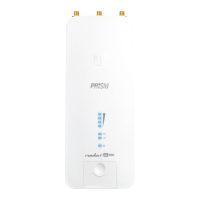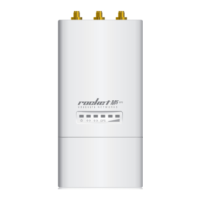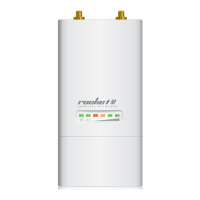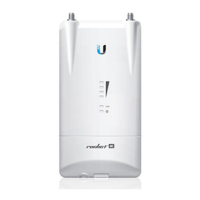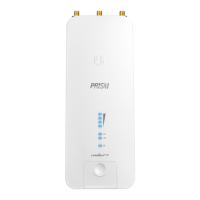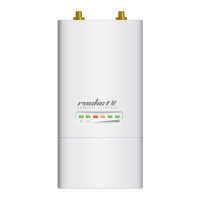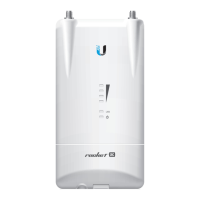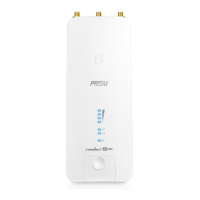
Do you have a question about the Ubiquiti RP5AC-PRISM and is the answer not in the manual?
| Model | RP5AC-PRISM |
|---|---|
| Wireless Standards | 802.11a/n/ac |
| Power Method | Passive PoE (Pairs 4, 5+; 7, 8 Return) |
| Operating Humidity | 5 to 95% non-condensing |
| Frequency Bands | 5 GHz |
| Max Data Rate | 450 Mbps |
| Power Supply | 24V, 0.5A |
| Operating Temperature | -30 to 70 °C |
| Dimensions | 300 x 300 x 60 mm |
| Enclosure Characteristics | Outdoor UV Stabilized Plastic |
| Processor Specs | MIPS 74Kc, 560 MHz |
| Memory | 64 MB DDR2 RAM |
| Networking Interface | 1 x 10/100 Ethernet port |
| Wireless Approvals | FCC, CE, IC |
| ESD Protection | 15 kV |
Lists the items included in the package, such as the Rocket5ac Prism, GPS Antenna, PoE adapter, and power cord.
Emphasizes the need for clear sky visibility for the GPS antenna to function correctly.
Recommends shielded Category 5 or higher cabling and proper grounding for Ethernet connections.
Identifies the RP-SMA connectors for external antennas and the GPS antenna connector.
Highlights the LED panel displaying status lights for the device's operation.
Indicates the protective cover for the device's ports.
Explains the function and default thresholds of LEDs indicating wireless signal strength.
Describes the steady blue light for GPS and activity indicators for LAN.
Explains the Power LED indicating when the device is connected to a power source.
Identifies the Gigabit Ethernet port for power and LAN connection.
Explains how to reset the device to factory defaults using the button on the unit or PoE adapter.
Guides on removing the port cover and connecting an Ethernet cable to the LAN port.
Details the step to put the port cover back after connections are made.
Explains connecting RF cables from the antenna to the RP-SMA connectors on the Rocket.
Describes how to align and lock the Rocket onto the antenna mounting slots.
Details connecting the other end of RF cables to the antenna.
Guides on connecting the GPS antenna to its specific connector on the Rocket.
Explains how to align and attach the protective shroud to the antenna mount.
Shows how to place the GPS antenna on the mounting hardware for optimal positioning.
Guides connecting the Rocket's LAN, host LAN, and PoE adapter to power outlet.
Describes preparing the bracket and mounting the PoE adapter at a desired location.
Ensures host system connection via Ethernet and configuration of static IP address.
Guides accessing the interface via web browser, logging in, and setting country/language.
States that devices must be professionally installed and operated within local regulations.
Highlights fields like Antenna Gain, Cable Loss, and Output Power for regulatory compliance.
Lists dimensions, weight, networking interface, and RF/GPS connector types.
Covers power consumption, operating temperature, humidity, and certifications.
Details worldwide and USA operating frequency bands for the device.
Advises reading instructions, heeding warnings, and using only specified attachments.
Emphasizes voltage compliance, qualified servicing, proper grounding, and connection safety.
Details the one-year warranty period, Ubiquiti's obligations, and common warranty voiding conditions.
Explains the requirement for a Return Materials Authorization (RMA) number for product returns.
Disclaims all warranties except those expressly provided, including merchantability and fitness for purpose.
Limits liability for issues related to buyer's equipment, internet, or third-party services.
States that Ubiquiti is not liable for direct, special, incidental, or consequential damages.
Notes that local laws may affect the applicability of warranty exclusions and limitations.
Details FCC rules compliance, including conditions for operation and interference.
Lists FCC-approved antenna types and their maximum permissible gain.
Outlines compliance with Canadian ICES-003 and RSS standards for interference reduction.
Lists Industry Canada approved antenna types and their maximum permissible gain.
Specifies the minimum separation distance required for antenna installation to ensure RF safety.
States product compliance with EU directives and explains the alert sign's meaning.
Warns that the Class A product may cause radio interference in domestic environments.
Provides instructions for disposing of the equipment according to European WEEE directive.
States that the device complies with essential requirements and provisions of Directive 1999/5/EC.
Provides links for product support, community forums, and software downloads.

